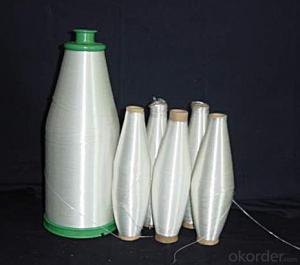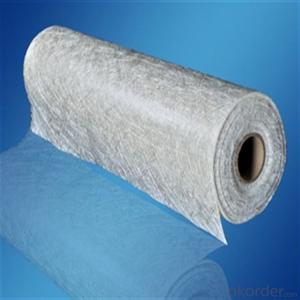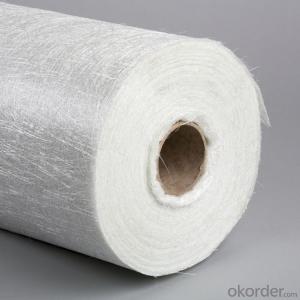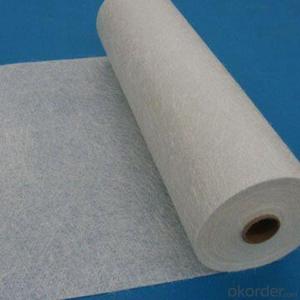E Glass Or C Glass Twisting and Plying Yarns
- Loading Port:
- Shanghai
- Payment Terms:
- TT or LC
- Min Order Qty:
- 20000 kg
- Supply Capability:
- 200000 kg/month
OKorder Service Pledge
OKorder Financial Service
You Might Also Like
Description:
C-or E-textile glass a kind of additional twisting and plying yam. With the characteristics of high strength, corrosion resistance, heat resistance and high moisture absorption, no-alkali yam has high electric insulation, so it used to produce weaved wires and cables’ wrap cladding, protection sleeve, train of mine, insulation materials of electric machinery, every yam of woven cloth and other industrial yam. It can also supply big and little paper cube and other cube yams with different shapes and different roll weight.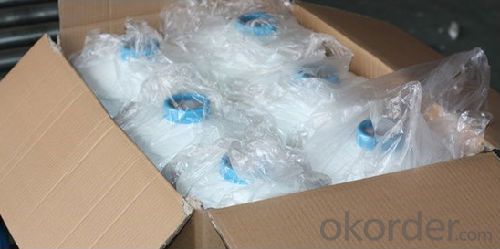 Product Features:
Product Features:
● Good Dispersibility.
● Less fuzzy.
● Density Even.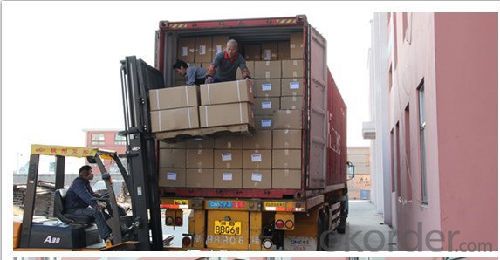 Product Specifications:
Product Specifications:
Product Code | Tex | diameter (um) | Sizing. | breaking strength | Twist |
CC7.5-22-1/2 110S | 44 | 7.5 | paraffin | ≥15.5 | 110±10 |
EC9-33-1/2 65S | 66 | 9 | ≥24.1 | 65±5 | |
EC8-25-1/2 65S | 50 | 8 | ≥19.2 | 65±5 | |
CC9-33-1/2 65S | 33 | 9 | ≥20.6 | 65±5 | |
CC11-44-6/0 | 264 | 11 | ≥81.6 | ||
CC11-44-1/3 110S | 132 | 11 | silane | ≥40.8 | 28±3 |
EC9-68-1/0 28Z | 68 | 9 | ≥18.0 | 28±3 |

Packaging:
conforms to strict standards on packaging of every single cone to ensure customers' satisfaction, from inspection on appearance of cone, color difference, flaws, etc. before packaging to the selection of proper plastic bags, labels inside the cone, and carton packing.
- Q:Can fiberglass chopped strand be used in aerospace composites?
- Aerospace composites can indeed make use of fiberglass chopped strand. Widely utilized in various industries, including aerospace, fiberglass chopped strand is a common material for reinforcement. Its strengths lie in its exceptional strength-to-weight ratio, chemical resistance, and thermal stability, making it a suitable choice for aerospace applications that demand lightweight and high-performance materials. Within the aerospace industry, fiberglass chopped strand finds its uses in the production of panels, fairings, interior parts, and structural elements. It can be combined with other reinforcement materials, such as carbon fibers, to further enhance the overall properties of the composite. However, it is crucial to consider the specific requirements and regulations of each aerospace project when selecting the appropriate reinforcement material.
- Q:Is fiberglass chopped strand suitable for automotive body parts?
- Yes, fiberglass chopped strand is suitable for automotive body parts. Fiberglass is a lightweight and strong material that offers excellent durability and impact resistance, making it ideal for automotive applications. Chopped strand mat, made of randomly oriented strands, provides reinforcement to the body parts, enhancing their strength and stiffness. Additionally, fiberglass is corrosion-resistant and can withstand harsh environmental conditions, making it a reliable choice for automotive body parts. Its versatility allows it to be easily molded and shaped into complex designs, providing flexibility for automotive manufacturers. Overall, fiberglass chopped strand is a suitable material for automotive body parts due to its strength, durability, and versatility.
- Q:Is fiberglass chopped strand resistant to UV rays?
- UV rays typically do not meet their match in fiberglass chopped strand. Over time, these rays can lead to the deterioration and alteration of fiberglass materials. Nonetheless, manufacturers frequently bestow a protective coating or finish upon fiberglass products to bolster their ability to fend off UV rays. To ascertain the UV resistance properties of their fiberglass chopped strand products, it is advisable to consult the individual manufacturer or supplier. Moreover, preserving the lifespan of fiberglass and reducing UV harm can be achieved by implementing adequate maintenance and protective measures, such as the application of UV-resistant coatings or avoiding direct exposure to sunlight.
- Q:How does the fiber dispersion affect the viscosity of chopped strand composites?
- Fiber dispersion affects the viscosity of chopped strand composites by increasing it. When the fibers are well-dispersed, they create a network within the composite, which hinders the flow of the matrix material. This interaction between the fibers and the matrix increases the viscosity of the composite, making it more difficult to process and shape.
- Q:Can fiberglass chopped strand be used for reinforcing foam materials?
- Yes, fiberglass chopped strand can be used for reinforcing foam materials. The chopped strands can be mixed with foam materials to enhance their strength, durability, and resistance to deformation.
- Q:Can fiberglass chopped strand be used in the production of wind turbine nacelles?
- Yes, fiberglass chopped strand can be used in the production of wind turbine nacelles.
- Q:What are the fire resistance properties of fiberglass chopped strand?
- Fiberglass chopped strand has excellent fire resistance properties. Its composition, which includes glass fibers, offers inherent resistance to heat and flames. Additionally, fiberglass is non-combustible and does not release toxic gases when exposed to fire. These properties make fiberglass chopped strand a popular choice for fire-resistant applications, such as insulation, fire doors, and protective clothing.
- Q:Is chopping glass fiber harmful to human?
- Classification of glass fiber (5) poor water-absorbing quality. The glass fiber monofilament diameter rangingfrom a few microns to twenty micron, with the development speed aheading. Its characteristics are as follows. (2) the elasticity coefficient is high, and the heat resistance is good: (1) High tensile strength It is widely used in various fields of national economy, but it is not suitable for being structural material thread, with the character of noninflammability, no radiation and special odors. (7) preety machinability. The English name is, therefore, with the resin to give shape after finally it can become excellent structural material, usually used as a composite material in the reinforcement material. (6) scale stability. (8)The transmission and light transmission make the use of glass fibers more broadly than other species of fibers, and it is insulating materials and insulation materials. Each bundle of fibers are made of hundreds or even thousands of root root filaments, woven cloth and other products, different the morphology of the staple fiber and glass fiber, so the absorption of impact energy is good: Glass fiber is equivalent to a hair and an be buddle into a strand. Glass fiber increases the intensity with diameter smaller. It is easily lunge the skin and belongs to a crisp fiber. (10) the price is cheap and fiber is very thin. Properties of glass fiber, high alkali: Finally, it becomes various types of products, so take good care of it.
- Q:How does fiberglass chopped strand affect the weight of products?
- The weight of products can be significantly affected by fiberglass chopped strand. Chopped strand, which consists of small, cut fibers of fiberglass material, increases the overall weight when introduced into a product or material. This occurs because fiberglass itself is relatively lightweight, but when incorporated as chopped strands, it enhances the density and weight of the end product. The desired weight and strength requirements can be achieved by adjusting the amount of chopped strand added. Furthermore, the weight of the product can also be influenced by the length and thickness of the strands. Longer and thicker strands contribute more weight compared to shorter and thinner ones. Ultimately, the inclusion of fiberglass chopped strand effectively elevates the weight and structural integrity of products.
- Q:How does the fiber dispersion uniformity of fiberglass chopped strand affect the quality of composites?
- The quality of composites is significantly influenced by the uniformity of fiber dispersion in fiberglass chopped strand. Fiber dispersion refers to how the individual glass fibers are evenly distributed within the composite material. To achieve optimal mechanical properties and overall performance, it is essential to have uniform fiber dispersion. When the chopped strands are evenly dispersed, they provide consistent reinforcement throughout the material. This leads to improved strength, stiffness, and durability. The uniformity ensures that the load is evenly distributed across the composite, minimizing the risk of weak spots or areas prone to failure. On the other hand, if the fiber dispersion is not uniform, it can result in various quality issues in the composites. Uneven distribution of fibers can create localized areas of high fiber concentration, causing stress concentrations and potential weak points. These weak points compromise the overall strength and structural integrity of the composite, making it more susceptible to cracking, delamination, and failure under load. Non-uniform fiber dispersion can also cause variations in the mechanical properties of the composite. Inconsistent reinforcement distribution leads to variations in stiffness, strength, and other mechanical characteristics across different regions of the composite. This lack of uniformity negatively impacts the predictability and reliability of the material, making it challenging to design and manufacture composite components with consistent performance. In conclusion, the fiber dispersion uniformity of fiberglass chopped strand is crucial for determining the quality and performance of composites. A uniform dispersion ensures even reinforcement distribution, resulting in improved mechanical properties and overall durability. On the other hand, non-uniform dispersion can lead to weak points, inconsistencies in mechanical properties, and reduced reliability of the composites. Therefore, maintaining a high level of fiber dispersion uniformity is essential for producing high-quality composites with consistent performance.
1. Manufacturer Overview |
|
|---|---|
| Location | |
| Year Established | |
| Annual Output Value | |
| Main Markets | |
| Company Certifications | |
2. Manufacturer Certificates |
|
|---|---|
| a) Certification Name | |
| Range | |
| Reference | |
| Validity Period | |
3. Manufacturer Capability |
|
|---|---|
| a)Trade Capacity | |
| Nearest Port | |
| Export Percentage | |
| No.of Employees in Trade Department | |
| Language Spoken: | |
| b)Factory Information | |
| Factory Size: | |
| No. of Production Lines | |
| Contract Manufacturing | |
| Product Price Range | |
Send your message to us
E Glass Or C Glass Twisting and Plying Yarns
- Loading Port:
- Shanghai
- Payment Terms:
- TT or LC
- Min Order Qty:
- 20000 kg
- Supply Capability:
- 200000 kg/month
OKorder Service Pledge
OKorder Financial Service
Similar products
New products
Hot products
Related keywords
